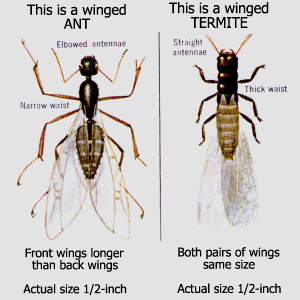Ants
 Ants are the number one urban pest today. Ants are social insects that live in colonies of large numbers of female workers, the queen and males. Workers are the caste typically seen in a structure. Numerous species of ants make control efforts difficult. Proper identification of the ant species is critical for implementing effective control measures. Ants invade houses through the tiniest cracks any time of year seeking stable environment. Unmated males and females have membranous wings and emerge for a nuptial flight and can confuse people in thinking they are termites. See fig. Ants are persistent and hard to control within structures. Selective baiting techniques, exclusion and reduction of conductive conditions are all viable non-chemical, "green" strategies.
Ants are the number one urban pest today. Ants are social insects that live in colonies of large numbers of female workers, the queen and males. Workers are the caste typically seen in a structure. Numerous species of ants make control efforts difficult. Proper identification of the ant species is critical for implementing effective control measures. Ants invade houses through the tiniest cracks any time of year seeking stable environment. Unmated males and females have membranous wings and emerge for a nuptial flight and can confuse people in thinking they are termites. See fig. Ants are persistent and hard to control within structures. Selective baiting techniques, exclusion and reduction of conductive conditions are all viable non-chemical, "green" strategies.
So, if you see ants, put one or two lightly on a piece of tape or in a plastic bag for TEAM to identify properly. Call TEAM quickly and we’ll visit you to solve all your pest control needs.
Carpenter Ants
Carpenter ants are the most conspicuous of ants found in and around structures. They are large black ants. Nests are typically constructed in moist or decaying wood. Carpenter ants do not consume wood, but rather construct their nest by ripping wood apart. Piles of sawdust or foraging workers throughout the structure are good indications of an infestation. Damage can be caused to the wood behind walls, moldings, railroad ties or siding not immediately visible. A thorough inspection is very important in carpenter ant management. Baiting, residual applications of pyrethrins and dusts in wall voids are all effective controls. Call TEAM with all your carpenter ant questions and we will be happy to perform a thorough, professional inspection.